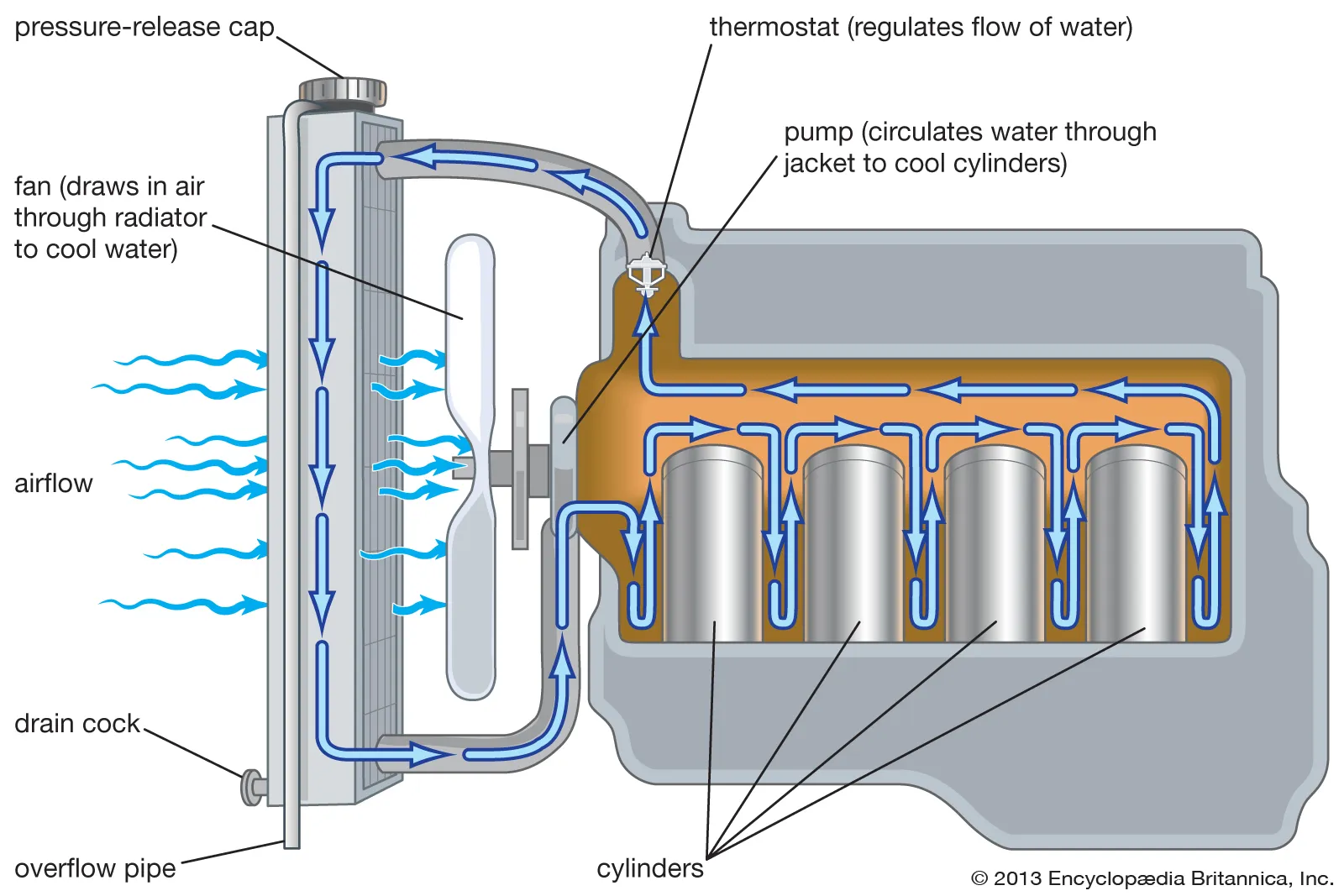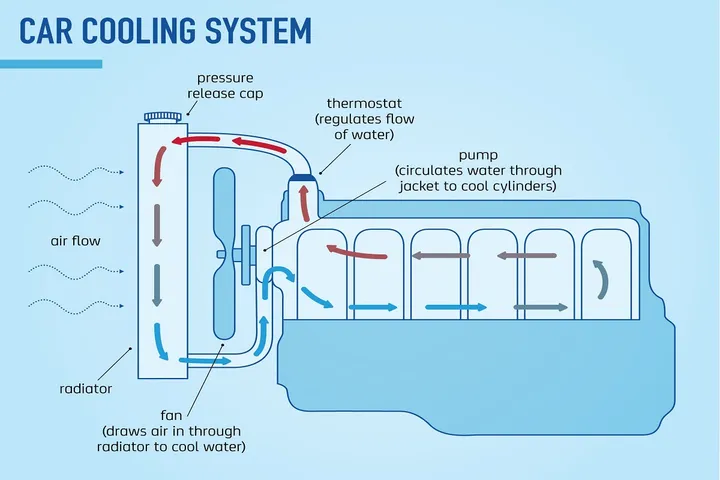


In the realm of automotive engineering, maintaining ideal engine temperatures is paramount for peak performance, fuel efficiency, and component longevity. Traditional cooling systems often rely on manual adjustments or external control mechanisms, which can be inefficient and prone to errors. Enter self-regulating coolant systems, offering an intelligent and seamless solution to automatically regulate coolant flow and temperature based on the engine's operating conditions. This comprehensive guide delves into the principles, components, and benefits of these advanced cooling systems, shedding light on their inner workings and their impact on the automotive industry.

Engines generate immense heat during operation, and if not effectively dissipated, it can lead to severe consequences like engine damage, reduced efficiency, and increased emissions. Proper cooling is essential to maintain optimal operating temperatures, ensuring smooth and reliable engine performance. While traditional cooling systems require constant monitoring and adjustments, self-regulating coolant systems offer a self-sufficient and intelligent solution, reducing the need for manual intervention and external control mechanisms. By maintaining optimal temperatures, these systems improve fuel efficiency, extend component lifespan, and reduce emissions, making them a game-changer in the automotive industry.
Self-regulation of coolant systems is achieved through various innovative mechanisms that respond to changes in temperature, pressure, and coolant properties, ensuring the system adapts to the engine's dynamic operating conditions.
A common self-regulating mechanism is the thermostatic valve or thermostat, which controls the coolant flow between the engine and radiator, ensuring efficient heat transfer and temperature regulation. These valves utilize temperature-sensitive elements like wax pellets or bimetallic strips. As the coolant temperature rises, the wax pellet expands or the bimetallic strip bends, causing the valve to open and allowing hot coolant to flow through the radiator for cooling.
Another self-regulating mechanism involves pressurized cooling systems, which maintain the coolant under pressure, raising its boiling point and allowing it to absorb more heat without boiling. The pressure is typically regulated by a radiator cap or pressure relief valve, which releases excess pressure when it exceeds a predetermined limit, preventing system damage.
Some advanced cooling systems incorporate phase-change materials (PCMs) or specialized coolants that undergo phase transitions (e.g., liquid to solid or vice versa) at specific temperatures. During these phase changes, PCMs can absorb or release large amounts of heat, known as latent heat, providing an additional layer of temperature regulation.
The chemistry and properties of the coolant itself play a crucial role in the effectiveness of self-regulating cooling systems. Different coolant types offer varying characteristics and benefits, each suited for specific applications and operating conditions.
| Coolant Type | Characteristics | Applications |
|---|---|---|
| Water-based | Excellent heat transfer, inexpensive, corrosion inhibitors, antifreeze additives | General automotive cooling systems |
| Glycol-based | Superior heat transfer, low freezing point, ethylene glycol or propylene glycol | Colder climates, food transportation |
| Phase-change | Latent heat absorption/release during phase transitions, paraffin-based or salt hydrates | Advanced temperature regulation |
The radiator plays a crucial role in dissipating heat from the coolant. Its design and airflow optimization are essential for efficient heat transfer and temperature regulation.
Fin density and core material impact heat dissipation capabilities, with higher fin densities and materials like aluminum or copper offering superior thermal conductivity.
Airflow optimization is achieved through fan design, ducting, and shrouds to direct and concentrate airflow through the radiator core.
Radiator placement and positioning within the engine compartment also contribute to airflow optimization.
The coolant pump is responsible for circulating the coolant through the engine and radiator, ensuring efficient heat transfer and temperature regulation.
Centrifugal pumps are commonly used, relying on an impeller to create centrifugal force and drive coolant flow.
Positive displacement pumps, such as gear or vane pumps, may be used in some applications, providing a consistent flow rate regardless of system pressure.
Coolant flow rate and pressure are critical factors, with higher flow rates and pressures improving heat transfer capabilities but excessive pressure leading to system stress and potential leaks.
Coolant hose design and routing play a role in minimizing flow restrictions and ensuring proper coolant circulation.
As coolant temperature fluctuates, its volume changes due to thermal expansion and contraction. Expansion tanks and overflow reservoirs accommodate these volume changes and maintain proper coolant levels.
| Component | Function |
|---|---|
| Expansion Tank | Accommodates coolant thermal expansion, preventing excessive pressure buildup |
| Overflow Reservoir | Captures excess coolant expelled due to thermal expansion or overpressure |
Many modern cooling systems incorporate coolant level monitoring systems to detect low levels and initiate corrective actions, ensuring optimal system performance.
The water jacket and heater core are integral components facilitating heat transfer and providing cabin heating and defrosting capabilities.
The water jacket surrounds the engine cylinders, allowing coolant to circulate and absorb heat from the engine block.
The heater core, a small radiator-like component, transfers heat from the hot coolant to the cabin air, providing heating and defrosting for the vehicle's interior.
Regular maintenance and diagnostic capabilities are essential for ensuring the longevity and optimal performance of self-regulating coolant systems.
Coolant flushes at recommended intervals remove buildup and replenish the system with fresh coolant.
Thermostat replacement is necessary to maintain temperature regulation efficiency as thermostats degrade over time.
Temperature and pressure sensors monitor operating conditions and alert drivers or initiate corrective actions if abnormal conditions are detected.
On-board diagnostic systems generate trouble codes related to the cooling system, helping identify potential issues like faulty sensors, coolant leaks, or thermostat malfunctions.
Self-regulating coolant systems contribute to improved energy efficiency and reduced emissions by:
Maintaining optimal engine operating temperatures, ensuring efficient combustion and minimizing energy losses due to overheating or overcooling.
Improving fuel efficiency as the engine operates at optimal performance levels without excessive heat buildup or cooling demands.
Reducing harmful emissions by mitigating overheating or overcooling, which can lead to incomplete combustion and increased emissions.
As automotive technology evolves, self-regulating coolant systems are poised for further advancements and innovations, such as:
Intelligent control algorithms and machine learning for predictive and adaptive temperature regulation.
Integrated sensor networks providing comprehensive data for precise and efficient self-regulation.
Predictive maintenance algorithms anticipating potential issues or component failures, enabling proactive maintenance and reducing downtime.
Augmented reality (AR) technology assisting technicians with real-time visual overlays and guidance during maintenance or repair procedures.
Blockchain technology for secure and tamper-proof maintenance records, ensuring transparency and traceability throughout the vehicle's lifecycle.
Self-regulating coolant systems have revolutionized the way automotive engines are cooled, offering a seamless and intelligent solution for temperature regulation. By leveraging innovative mechanisms like thermostatic valves, pressurized cooling, and phase-change materials, these systems automatically adjust coolant flow and temperature based on the engine's operating conditions. The benefits are numerous, including improved fuel efficiency, extended component lifespan, reduced emissions, and simplified maintenance requirements. As technology continues to advance, further innovations in this field, such as intelligent control algorithms, integrated sensor networks, and augmented reality assistance, will further enhance the performance and efficiency of these remarkable cooling systems.
The article mentions water-based, glycol-based, and phase-change coolants. Water-based coolants are commonly used with corrosion inhibitors and antifreeze additives. Glycol-based coolants offer superior heat transfer and low freezing points.
Pressurized cooling systems maintain the coolant under pressure, raising its boiling point and allowing it to absorb more heat without boiling. The pressure is regulated by components like radiator caps or relief valves.
Phase-change materials undergo phase transitions (liquid to solid or vice versa) at specific temperatures, absorbing or releasing large amounts of latent heat, providing an additional layer of temperature regulation.
Radiator design factors like fin density, core material, and airflow optimization through fan design, ducting, and shrouds significantly influence heat dissipation capabilities and cooling efficiency.
Coolant pumps, typically centrifugal or positive displacement pumps, are responsible for circulating the coolant through the engine and radiator, ensuring efficient heat transfer and temperature regulation.
Expansion tanks accommodate coolant thermal expansion, preventing excessive pressure buildup, while overflow reservoirs capture excess coolant expelled due to thermal expansion or overpressure.
Water jackets surround the engine cylinders, allowing coolant to circulate and absorb heat from the engine block. Heater cores transfer heat from the hot coolant to the cabin air for heating and defrosting.
Regular maintenance, such as coolant flushes and thermostat replacements, is essential to remove buildup, replenish the system, and maintain temperature regulation efficiency over time.
By maintaining optimal engine operating temperatures, self-regulating cooling systems ensure efficient combustion, minimize energy losses due to overheating or overcooling, and improve fuel efficiency.
Potential advancements include intelligent control algorithms, integrated sensor networks, predictive maintenance algorithms, augmented reality assistance for technicians, and blockchain technology for secure maintenance records.

Miguel started tinkering with car radios as a teenager, fascinated by the intricate dance of wires and circuits. This passion led him to pursue a career as an automotive electrician. For the past 10 years, Miguel has tackled everything from flickering headlights to mysterious electrical gremlins. He thrives on troubleshooting electrical problems and enjoys sharing his knowledge to empower car owners to understand their vehicles better.







